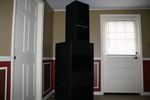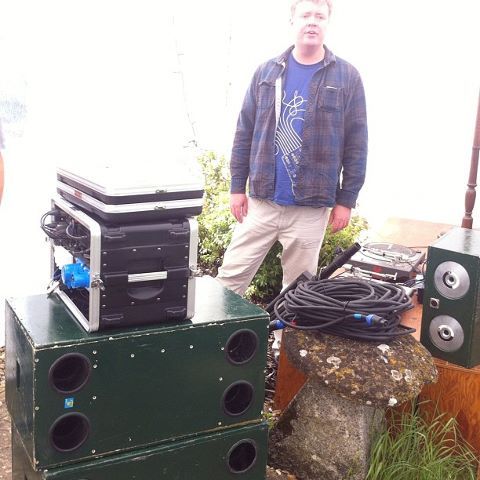- Posts: 5
- Thank you received: 0
Time Alignment/Delay
- neillakhansingh
-
 Topic Author
Topic Author
- Offline
- New Member
-

Please Log in or Create an account to join the conversation.
- Rog Mogale
-

- Offline
- Premium Member
-

- Posts: 120
- Thank you received: 19
This is not as easy as you think to do correctly. I used to think you could just measure the distances from the drivers to the listening point and calculate the delays from that. I have even suggested that in one of my FAQ’s on the speakerplans website, but that was written around 12 years ago when my knowledge was not as good as it is now. I also have lots of hi end test gear now that can really let you see what’s going on in the time and phase domain, again something I didn’t have 12 years ago which led me to think differently about setting delays between bands.
I’m going to answer you question with a reply I made to someone that asked me about using X1 subs under some Stasys 8 cabs he owned. This will be different from you application as it sounds like you are not going to run 2 way bass. But it illustrates the point in that to do this properly you need test equipment and know how to use it to get the optimum delay times. (= a mate with a 30 day demo of Smaart, a laptop, an external USB sound card with 48V phantom power, a berry measurement mic and a brain).
Here is my reply to his question, which was “I need to set the delays between some Stasys 8’s and X1’s, can you tell me the path length from the driver to the front of the cabinet please”.
My reply:
Unfortunately knowing the physical path length on a Stasys 8 or X1 will not help much with setting the delay between them. This is also not helped because the output from an X1 is produced from ports, which introduce phase shifts.
You have to start looking at group delay (GD) and the phase response to get an idea of which frequencies are being produced at any given time. This is best measured with an RTA program. If you can borrow an RTA setup or get someone with one to help you out you will get the best out of the Stasys 8 and X1 configuration.
I’ve had a look at the Stasys 8’s GD plot and from 80Hz up to 150Hz the GD is quite flat at 2.5ms. I’ve quoted the 80 to 150 range as this is where most will crossover into the midtops. Below 80Hz the GD rises up to a peak of 8ms and remains constant and quite even from 70Hz down to 40Hz. But without knowing the GD of an X1 and I’ve never measured the GD of one, its impossible to give a delay figure to apply. A pure guess at looking from simulations would suggest a GD of about 14ms at 60Hz for an X1. This of course would rise considerably below 60Hz and would probably peak out around 19 to 22ms from 40Hz and below. A good place to start experimenting with the crossover freq between the X1 and Stasys 8 would be 60Hz I feel. There is still a lot of very useful output down to 60Hz from a Stasys 8 and because of its low and uniform GD response I’d want to get the widest freq range playing from the Stasys 8 and just use the X1 for a bit of extension. You could try a 0ms delay on the X1, 6ms of delay on the Stasys 8 and whatever is required to align your midtops to the Stasys 8 plus the delay time from the Stasys 8 to the X1. All this is of course complete speculation as I don’t have a GD or phase response for an X1.
If you really can’t get the system aligned via an RTA then set the delay times I mentioned above and have a listen with some music with a kick drum that has a strong attack and a lot of LF content. If the low notes are playing slower than the upper transient or click of the kick, then set more delay on the Stasys 8 and midtops. This of course is no way to correctly align a system or get the best from it, but will give you something useable if you are in a hurry. A cheap SPL meter and the sine wave test tracks available on the support page of the Void website or PC sine wave program could then be used to get a better sum at the crossover frequency.
I hope you can start to see why the path lengths of different bass cabs have very little relevance to how quick or slow they play. Assuming the X1 has a GD of around 14ms at 60Hz, this would give it a path length of 4.8 meters. As can been seen the X1 cabinet is not 4.8 meters deep. You can in fact put your arm though the port and touch the driver, but in reality its like the whole cab is 4.8 meters from you when its playing 60Hz. The GD figure of 8ms from 40Hz to 70Hz for the Stasys 8 would suggest its path length is 2.74 meters. But in reality the distance from the centre of the driver to the front of the cab measured from the middle of the horn is a lot less.
So to answer your original question. A Stasys 8 has a path length of 2.74 meters at 60Hz and an X1 would probably have a path length of 4.8 meters at 60Hz. Take 2.74 meters from 4.8 meters and you are left with a difference of 2.06 meters, which equates to a delay time of 6ms. You can look at this another way too. Imagine the cabs are in front of you on the ground. When the Stasys 8 is playing a note of 60Hz it will be 2.74 meters away from you. The X1 will be 4.8 meters away from you. If you walk 2.74 meters forwards then you will be at the place the Stasys 8 is emitting that 60Hz. This means that the X1 will be 2.06 meters behind the Stasys 8 when producing 60Hz, hence delaying the Stasys 8 by 2.06 meters so that it lines up with the X1. Any midtops would need to be delayed by around 4.8 meters to appear at the place the Stasys 8 and X1 are at. The distance/delay of the midtop cab will change depending on its GD and phase properties.
So all this works for 60Hz, pick any other frequency and the distance would change for either of those cabs, meaning 6ms could be way off. Also GD can only get you so close, as you will need to know what part of the cycle each band is on to get a perfect summation. A phase response plot will help here.
To sum it all up, ‘a tape measure has no place in determining the delay settings when aligning a sound system’.
Rog.
Please Log in or Create an account to join the conversation.
- Rog Mogale
-

- Offline
- Premium Member
-

- Posts: 120
- Thank you received: 19
Even in a mid top design using small component radiating areas it cannot be assumed that the delay prorogation of each component will be zero. There will always be frequency dependant propagation delay because of differing radiation masses, the speed of emission though the material and the differences in materials themselves. So basically no two different transducers will exhibit the same GD and resulting phase data because of the mass of the cone (or dome in small HF units) and the way the cones material affects how sound moves though it.
Lower frequencies by nature will always arrive later because of increased resistance to air load and mass. Break up modes and nodal resonances will also affect the time domain prorogation higher up in the response. Cabinet design and location of the transducers will also play a part. So in midtop or fullrange design, even if it’s a small 10”, 4” dome and 1” dome for Hi Fi use, ultimate phase integrity cannot be assured by physical alignment of the 3 different transducers alone. To do so would require a constant phase response of all the components over there intended bandwidth and that each component shared the same phase response, which is impossible. These differences are brought about due to the each component seeing a different air load, having a different moving mass, a different cone profile and cone material. The best that can be achieved presenting the least disruption in the time domain would be to match both propagation delay and phase artefacts at each components xover point. This means some transducers will have to be either physically or electronically moved with regard to the mean axis of radiation to achieve the least destruction though the xover area. To see many transducers psychically time aligned without compensation for propagation irregularities and then say ‘its time aligned’ is missing the point.
To me timing is more important than frequency response. I’ve said this many times and explained why at demos I’ve done over the years. How quick our receptors can respond to timing discrepancies will be different for each individual and there dopamine levels/threshold.
To put that very simply, the physical interaction, the activation of NMDA receptors alters the topography and movement of D1 receptors by trapping them in dendritic spines and thus altering their distribution. In a second physical interaction, D1 and subunits of NMDA receptors form heterodimers, which are translocated from the cell interior to the surface. Finally, a third physical interaction posits that the C terminus of D1 receptors makes contact with subunits of the NMDA receptor. These physical interactions can attenuate or potentiate receptor function. In contrast, the more traditional interactions mediated by second messengers generally cause NMDA receptor function to be potentiated through the activation of D1 receptors and the cAMP–PKA–DARPP-32 [adenosine 3',5'-monophosphate (cAMP)–protein kinase A–cAMP-regulated phosphoprotein of 32 kD] or PKC (protein kinase C) cascades. Together, these mechanisms provide a basis for understanding the increasing complexity of D1-NMDA receptor interactions and their importance in physiological and pathological processes.
Rog.
Please Log in or Create an account to join the conversation.
- kevinmcdonough
-

- Offline
- New Member
-

- Posts: 11
- Thank you received: 0
as Rog says measuring is really the only sure way. While physical distance causes a delay that has to be accounted for, so does group delay of the speakers, any delay (latency) caused by processing or whatever. Its the delay of the system as a whole that has to be measured. Smaart will allow you to do it, or one of the measurement programs like ARTA or Room EQ Wizard.
In terms of the actual practical steps, I've always found it easiest to do a basic impulse measurement of each section of the sound system first. Whichever has the latest impulse (usually the subs) you then need to delay everything else to match. This will get you ballpark correct.
Then to get things exact you need to start at the bottom and work your way up. Start at the bottom two sections and do a proper measurement with phase data. Pay particular attention to the crossover frequency and Adjust these so that they have a flat response over their respective bandwidths and that they are in phase at the crossover point. once your happy with these, lock them of and move up to the next crossover, again EQing and adjusting till its in phase and your happy with the response. Lock these off and move up again, continuing till the whole system is EQ'd flat and the crossover points are all in phase and everything sounds hunky dory
k
Please Log in or Create an account to join the conversation.
- crossed
-

- Offline
- Senior Member
-

- Posts: 78
- Thank you received: 2
Please Log in or Create an account to join the conversation.
- chaudio
-

- Offline
- Platinum Member
-

Once I started using this method to align my systems the difference was very noticable. It sounded very much more 'coherent'.
Rog is very much correct that even if things look like they are physically aligned, it's not quite that simple. For example, when setting up my main system of 18" reflex subs and twin 12" reflex mid-tops, you would assume that if they were stacked on top of each other, fronts flush they'd be pretty close to being aligned. I actually found I needed to compensate by about 1ms which is roughly 1ft or 30cm difference.
Please Log in or Create an account to join the conversation.
- bee
-

- Offline
- Platinum Member
-

- Posts: 2090
- Thank you received: 34
Please Log in or Create an account to join the conversation.
- jsg
-

- Offline
- Elite Member
-

- Posts: 236
- Thank you received: 0
1. Check the drivers are all set to the same polarity (+ve signal=forward cone motion)
2. Rough-estimate GD for each channel (obviously better to measure if the kit is available). Estimating means adding up various numbers:
- path length difference, i.e. shortest path from cone to front of stack, convert to time using 1 foot->1ms
- delay due to speaker upper rolloff, this is the effect of a low-pass filtering effect. Delay is approx order/(4*freq) ms. Order is usually 1 for direct radiator and simple horn, 2 for bandpass horn and simple bandpass, 4 for complex (3-chamber) bandpass. Use the driver's own upper rolloff, not xover freq.
- delay due to resonant peak. Hard to estimate. You could use a simulation for a rough figure. I usually don't cross over near a resonant peak though, in which case this figure can be omitted.
- delay due to xover rolloff. Same formula as speaker rolloff, i.e. order/(4*freq) ms. Use the upper cutoff freq set in xover for that range (skip this part if no upper limit). order here is slope/6dB. So eg 1KHz 24dB/oct gets you order=24/6=4 and delay=4/(4*1000)=1ms
Add all these up. Note that these are all approximate. Really, this stuff only needs to be accurate enough to get you within 1 period of the correct delay.
Now just set the relative levels to taste, set the xover slopes so that both sides are at -6dB at desired xover freq (allowing for any roloff theat the speaker is doing) and set the delay of the upper side to match using the above figures (so upper delay setting = lower delay setting + lower calculated delay - upper calculated delay).
Now flip one side into invert, run a sinewave at the desred xover freq and search for a null by tweaking the upper delay and the freq of the sine wave. Now flip off the invert and you're all good.
I do the estimation part first because, as both Rog and Chris mention, total group dealys can be a lot bigger than jsut the path length component. You can (and I have) found a phase match using the nulling method that was off by at least one entire cycle at the xover freq.
For example in the TY low mid->high mid (800Hz), the path-length difference is less than 1 ms. But one I factor in the TY mid's rolloff order (which is high due to being a bandpass system) and the xover rolloff and I got nearer 3ms difference. So I searched for a match by nulling near 3ms and was happy with the results.
Ars est celare artem
Please Log in or Create an account to join the conversation.
- jsg
-

- Offline
- Elite Member
-

- Posts: 236
- Thank you received: 0
jsg wrote: Agree with the above comments. The process I usually use goes something like this:
1. Check the drivers are all set to the same polarity (+ve signal=forward cone motion)
2. Rough-estimate GD for each channel (obviously better to measure if the kit is available). Estimating means adding up various numbers:
- path length difference, i.e. shortest path from cone to front of stack, convert to time using 1 foot->1ms
- delay due to speaker upper rolloff, this is the effect of a low-pass filtering effect. Delay is approx order/(4*freq) ms. Order is usually 1 for direct radiator and simple horn, 2 for bandpass horn and simple bandpass, 4 for complex (3-chamber) bandpass. Use the driver's own upper rolloff, not xover freq.
- delay due to resonant peak. Hard to estimate. You could use a simulation for a rough figure. I usually don't cross over near a resonant peak though, in which case this figure can be omitted.
- delay due to xover rolloff. Same formula as speaker rolloff, i.e. order/(4*freq) ms. Use the upper cutoff freq set in xover for that range (skip this part if no upper limit). order here is slope/6dB. So eg 1KHz 24dB/oct gets you order=24/6=4 and delay=4/(4*1000)=1ms
Add all these up. Note that these are all approximate. Really, this stuff only needs to be accurate enough to get you within 1 period of the correct delay.
Now just set the relative levels to taste, set the xover slopes so that both sides are at -6dB at desired xover freq (allowing for any roloff theat the speaker is doing) and set the delay of the upper side to match using the above figures (so upper delay setting = lower delay setting + lower calculated delay - upper calculated delay).
Now flip one side into invert, run a sinewave at the desred xover freq and search for a null by tweaking the upper delay and the freq of the sine wave. Now flip off the invert and you're all good.
I do the estimation part first because, as both Rog and Chris mention, total group dealys can be a lot bigger than jsut the path length component. You can (and I have) found a phase match using the nulling method that was off by at least one entire cycle at the xover freq.
For example in the TY low mid->high mid (800Hz), the path-length difference is less than 1 ms. But one I factor in the TY mid's rolloff order (which is high due to being a bandpass system) and the xover rolloff and I got nearer 3ms difference. So I searched for a match by nulling near 3ms and was happy with the results.
Correction: where I say "Use the driver's own upper rolloff, not xover freq.", I should say, use the upper rollof freq of that component of the assembled speaker, i.e. combination of driver and enclosure. Sometimes the rolloff will be dictated by the driver (eg sealed box), other times by the enclosure (eg bandpass)
Ars est celare artem
Please Log in or Create an account to join the conversation.